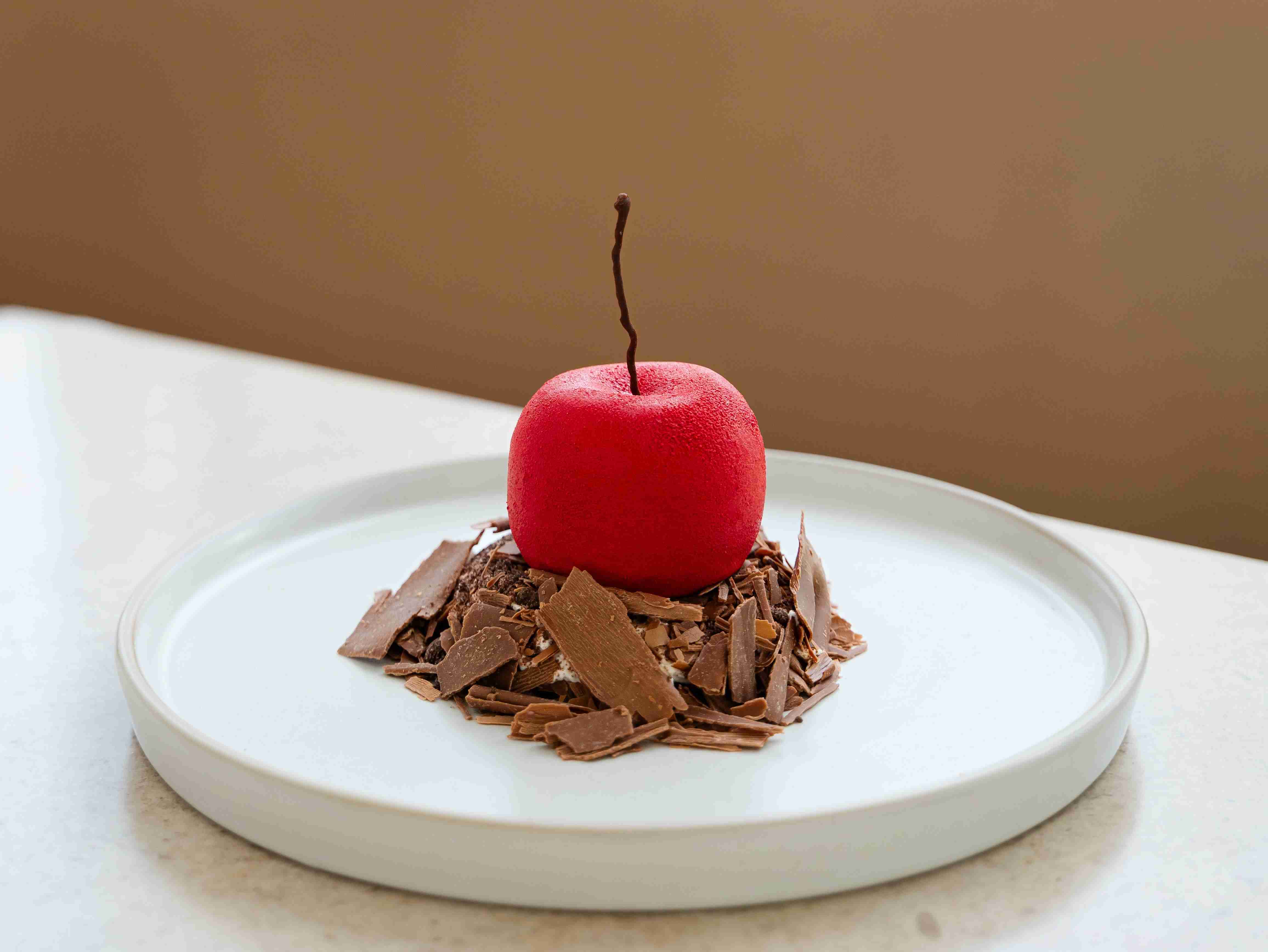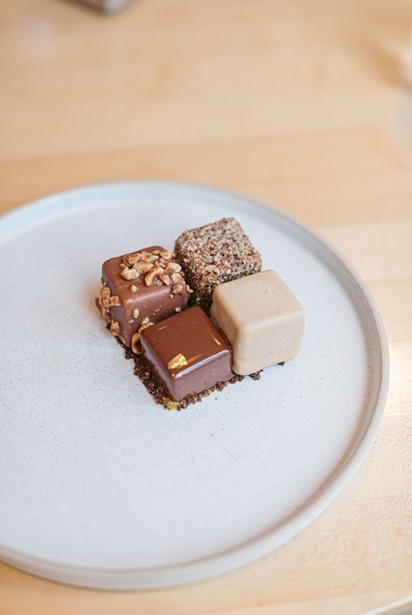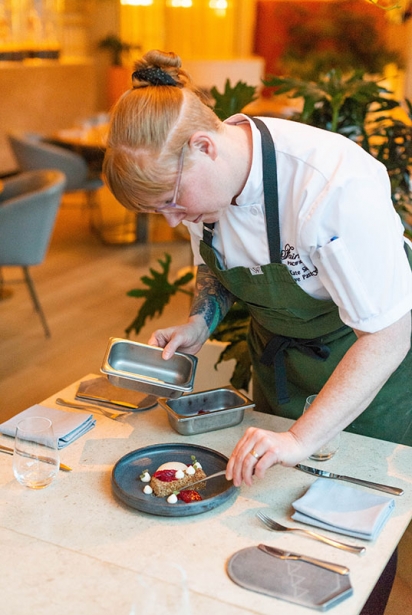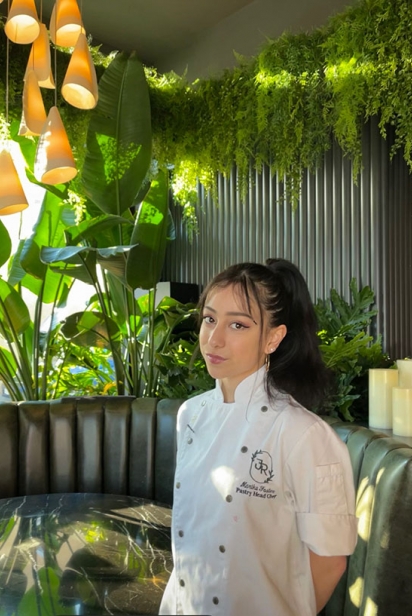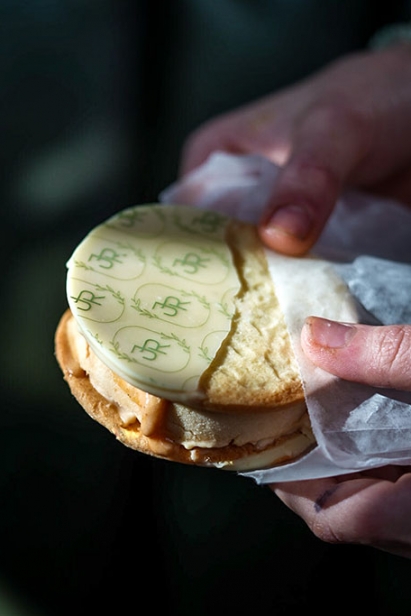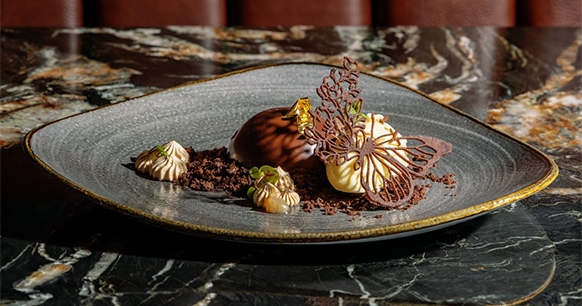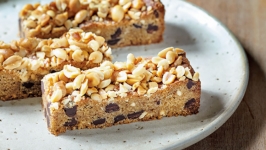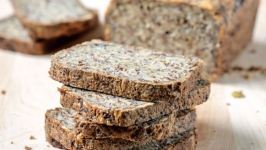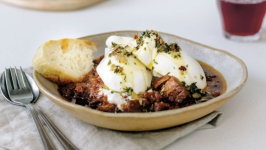The Sweet Side
It’s just an ice cream sandwich. Then again, it’s not just any ice cream sandwich. It’s caramel-miso ice cream threaded with gloriously gooey bits of caramel, tucked inside an almond shortbread biscuit, finished with white chocolate and stamped with the restaurant’s logo. And it took Jungle Room pastry chef Mariko Foster weeks to get it just right.
“The amount of times I have to redo a recipe to get it perfect,” Foster says, without finishing her sentence. “But when I get it perfect, it’s a real achievement.”
Pastry, you see, is not like anything else in the restaurant kitchen. It is science and art and a little bit of magic, often misunderstood and even more often undervalued. When money is tight, the pastry chef is usually the first to go, a frivolous “nice-to-have” rather than a must-have. Yet pastry can be the most memorable part of the meal, the Instagrammable work of art that lingers long in the memory after the rest of the meal fades away.
Mostly, pastry is a little bit of a mystery. It’s not just about pretty desserts (though of course it’s that, too). There is serious technical know-how that goes into every buttery bite. As Patrick Gayler, the executive chef at Mission Hill Family Estate Winery, says: “Everything else you can mess up and fake your way through it. Not pastry.”
Patience and precision
After Steven Hodge graduated from school, he was living in California, unhappy with his career options, working at a gym and cooking for a girlfriend who liked his food so much that she inspired him to go to cooking school.
“True story,” he says. “I saw a book on sugar art and chocolate art. I asked the chef instructor about it and he said, ‘We don’t do that.’” So Hodge switched his studies to pastry and never looked back.
Today he is a chocolatier and pâtissier, owner of Temper Chocolate & Pastry in West Vancouver, and the co-host, with Anna Olson, of Food Network Canada’s “Great Chocolate Showdown.”
“I’ve always had a sweet tooth,” he says. “Dessert was always my favourite thing. I love the science of it. Everybody knows that when you bake muffins, you use baking powder, but nobody knows why.”
He laughs a little. “I hated high school, but I loved the science.” Foster, on the other hand, loves the art of pastry.
“I come from a family of creatives. I always knew I was going to be in that domain,” she says. “Ever since I was young, I was in love with intricate and beautiful desserts. In school, I was never good at science and math, but when I’m cooking, it’s easy to understand. It is personally satisfying, and there’s always something to learn.”
Whether drawn by the art or the science, in a restaurant kitchen, the pastry chef (or pâtissier) is responsible for the baked goods from the bread served at the beginning of the meal to the chocolate truffles that arrive with the bill at the end of it. In bigger kitchens, the pastry chef might also oversee the boulanger (who makes bread and breakfast pastries), the confiseur (who prepares candies and petits fours), the glacier (who makes ice cream and other cold desserts) and the décorateur (who crafts specialty cakes and show pieces).
But pastry chefs are not confined to being part of a restaurant brigade. Indeed, says Sylvia Potvin, president and owner of the Pacific Institute of Culinary Arts, many students come to pastry already planning to start their own business. “In pastry, people tend to be more self-starters,” she says.
“Usually, they really like sweet stuff,” adds Eulalie Hermand, the Pacific Institute of Culinary Arts’ foundations pastry instructor and the former executive pastry chef for Ladurée Canada. But most of all, she adds: “You need to be patient and precise and then you will make something incredible.”
Starting with the basics
Technically, you don’t need to go to school to become a pastry chef. Foster didn’t. She’s been working in pastry for seven years, two of those at Thierry Chocolates on Alberni Street, where she spent a year learning the craft.
“I was lucky to have a lot of dedicated pastry chefs to learn from, including Thierry himself,” she says, referring to the café’s namesake master chocolatier and pâtissier, Thierry Busset.
Kate Siegel, on the other hand, did go to school. She studied culinary arts at George Brown University in Toronto, where she quickly gravitated to pastry.
“When I was at school, I found pastry just suited my temperament a bit better,” says Siegel, who is now the executive pastry chef at Fairmont Pacific Rim, where she oversees the dessert programs for Botanist and The Lobby Lounge as well as in-room dining and banquets.
“I find in pastry there’s more artistry — you can play a bit more,” she adds. “I’m a bit of a perfectionist and that speaks to me. It’s also a way more hands-on technical skill that you over the years very much develop a feel for. Once you develop a feel for it, you can play a bit more.”
At the Pacific Institute of Culinary Arts, students study pastry and baking together and a full-time professional baking and pastry arts diploma takes six months to complete.
“We have a lot of bread lovers,” Hermand says. (The Pastry Training Centre of Vancouver’s diploma program takes three months, comprising 256 hours of training; Le Cordon Bleu in Ottawa, meanwhile, offers three levels of training, three months each, to complete the Diplôme de Pâtisserie. There are also courses available for home bakers who just want to learn the skills for their own satisfaction.)
Training starts with the basics — think cakes and cookies — then moves toward more technical things such as choux pastry, caramel, ice cream and chocolate. Students need to learn not just how to follow recipes, but to understand the science of how and why things work the way they do, for instance, how temperature affects chocolate or elevation influences leavening.
“There’s a progression. They start with really simple batters to understand how ingredients go together,” says Hermand. “Then they create products according to what they learned.”
Invert sugar and offset spatulas
Cooking is chemistry. That’s the message behind the best-selling novel (and the TV show that’s based on it), Lessons in Chemistry by Bonnie Garmus. But pastry is all the other sciences as well — it’s physics, mathematics, engineering and a generous pinch of social science.
Take the ingredients with which pastry chefs work. Think baking and you likely think butter, sugar, flour and eggs. But pastry chefs also use things that are a bit harder to find at the grocery store, things such as invert sugar, callets, leaf gelatin, lustre dust, agar agar and gold leaf. (“[For] things like invert sugar, as a home cook you could substitute white corn syrup,” Siegel notes.)
Even vanilla is anything but basic in the pastry kitchen. It can come in bean, seed, paste, extract, sugar, syrup or powder format.
And then there are the tools. “It’s very different,” Hermand says. “We are working a lot with stand mixers, but we also have a lot of tools, different spatulas, and we use way more moulds and rings.”
There are, for instance, sheeters for laminating croissants and puff pastry, tempering machines for keeping melted chocolate at just the right heat for a shiny gloss, perforated baking sheets for avoiding the dreaded soggy bottom on tarts and silicone mats that are, as Hermand says “crucial for macarons.” Plus, there are countless moulds — ring moulds for tarts and others for madeleines, financiers, canelés and those chocolate spheres that melt with so much drama when you pour flaming brandy over them.
And don’t forget the piping bags and tips.
“We have so many tips. After spatulas, it is the tool for so many things we do on the pastry side,” Hermand says. “And in contrast to culinary, there are basically no knives. In pastry, even a blunt paring knife is just fine.”
The other side of the kitchen
It’s not just the equipment that’s different on the pastry side of the kitchen. Almost everything else is, too. For one thing, Hodge says, you only have one shot at getting things right. “If you ruin a steak, you can fire another one. If you ruin the bake, you don’t have another bake.”
Also, he says, the order in which things are done is different — culinary chefs spend all day prepping and then cook. “But in pastry it’s the opposite. With us, we bake everything in the morning and then we go into production,” he says.
Everything takes a lot longer. “The pastry is done in advance — our croissant dough takes two days to prepare,” he says. “We can prepare cakes months in advance if we use a blast freezer.” (A blast freezer can freeze food so quickly it doesn’t lose any moisture or flavour or result in freezer burn.)
It takes time for yeast dough to rise or ice cream to freeze, gelatin to set or a tart shell to blind bake. “Things take more time, so bakers have to be patient. It can take a while before a cake is built,” Hermand says.
But that time can also be a gift. “We have the privilege to mould and shape things a bit more,” Siegel says. Adds Foster: “I find that a lot of stuff in the kitchen is in the moment, but in pastry it has to be pre-planned. It’s a lot less in-the-moment go-go-go energy.”
Pastry also demands meticulous attention to detail — from precise measurement to understanding how each ingredient works and the impact of the environment on it. “No matter what you know, your environment can change everything,” Hodge says.
On a hot, humid day, for instance, chocolate won’t set and meringues won’t crisp, but yeast will happily bubble away. On cold days, yeast may not rise at all. At high altitudes, leaveners can rise too fast and then collapse, resulting in fallen cakes and leaden loaves. And then there’s butter — the right temperature will make all the difference between light, flaky layers and a greasy melted mess on your baking sheet.
While the culinary side can get away with a pinch of this, a dash of that and a Salt Bae-like flair for measuring things, being off even a gram or two in baking can make all the difference between delight and disaster. (To wit: Pastry chefs will tell you that all ingredients should be measured in weight, preferably grams, for the greatest accuracy. A cup of flour, for instance, can vary from 120 to 145 grams depending on how humid the air is, the type of measuring cup used and how firmly you packed it. But 120 grams is always 120 grams.)
“The pastry side is more precise. Often we refer to the culinary side as art and the pastry side as science. It’s a little bit of both,” Hermand says. “But there is no room for improvisation on the fly. Everything is scaled and measured precisely to get the results we are looking for. People going into pastry have to be comfortable with that.” There is one other significant difference between culinary and pastry. In the testosterone-fuelled world of restaurant kitchens, pastry seems to attract — or maybe retain — more women, even though Potvin notes that her classes are almost evenly split between the sexes.
“It is very hard to be a woman in the kitchen, that’s no secret,” Foster says. “Because there are so many other female chefs in pastry, there’s a comfort in it. It’s safer, in a way.” Adds Siegel: “Maybe it’s a chicken-and-egg thing. When you get into a kitchen you can’t help but see where the women are. If you see it, you can be it.”
Delicious opportunity
Ultimately, the appeal of pastry is neither science nor art, but the sweet intersection of the two that allows for endless creativity. As Siegel points out, “On the savoury side there are only so many ways you can prepare a filet of beef, but there are infinite ways to present chocolate.”
For instance, as late summer changed to fall and winter, she created a new dessert menu for the Botanist that featured a toasted maple nut tart with a red kuri squash ice cream subtly flavoured with rosemary.
“I love making ice cream,” she says. “And I love using a lot of fall vegetables [such as parsnips or squash] in dessert. They have a lot of sweetness that can be overlooked,” she says. “My favourite thing to make is always the next dish I’m working on. I’m always excited about the next thing that’s in season.”
Foster, meanwhile, has just discovered the surprisingly vast possibilities of vegan pâtisserie.
“Until now, I thought vegan would be really hard to achieve because pastry is all about eggs, butter and cream. Dairy-free and vegan just doesn’t go with dessert,” she says.
But she’s proud of the vegan list she recently created for Jungle Room. “I always look for recipes that are naturally vegan or gluten-free, so I don’t have to compromise anything.”
Hodge and Hermand, on the other hand, are crushing on croissants. “I love making croissants,” Hodge says. “I love the science of getting your butter to just the right temperature.”
Croissants combine a yeast dough with lamination (the process of folding and rolling butter into dough over and over again to create super-thin layers), which calls for more precision, technical know-how and space than most bakers can manage at home. But they are hugely trendy right now, especially with all the fabulous new flavours and shapes we’re seeing, the cruffins and cronuts and filled croissants, as well as traditional “snails” — pain au chocolat and kouign-amann.
“Croissants are really fun to play with,” says Hermand. “Most of my students are really looking forward to lamination week.”
But the world of pastry is also rich with candies and chocolates, cookies and cakes, mousses and crémeux, super-trendy tuiles and fashionably composed plates. It can be as simple as a buttery shortbread cookie or as complex as a multi-tiered cake held together with wooden dowels and adorned with a fantasia of royal frosting, edible flowers and pretty little candied accoutrements.
Most of all, it’s a world filled with opportunity for everyone, as long as they have the patience for it. And if that opportunity arrives decked in perfectly tempered chocolate and technically perfect spun sugar, well, that just makes it all the sweeter.


